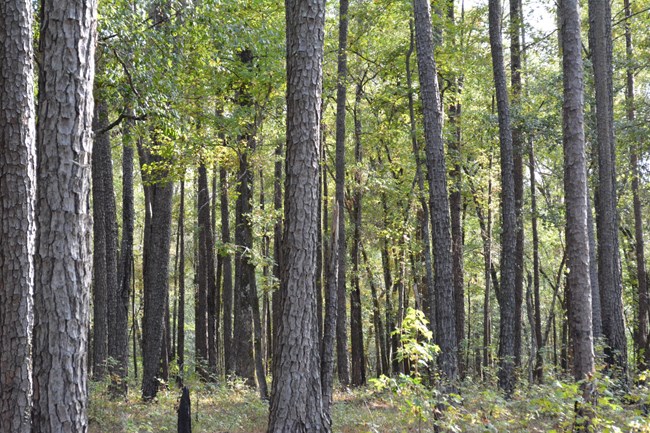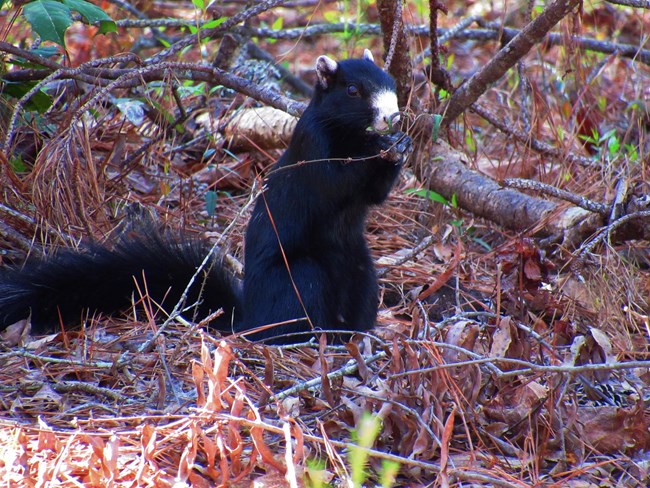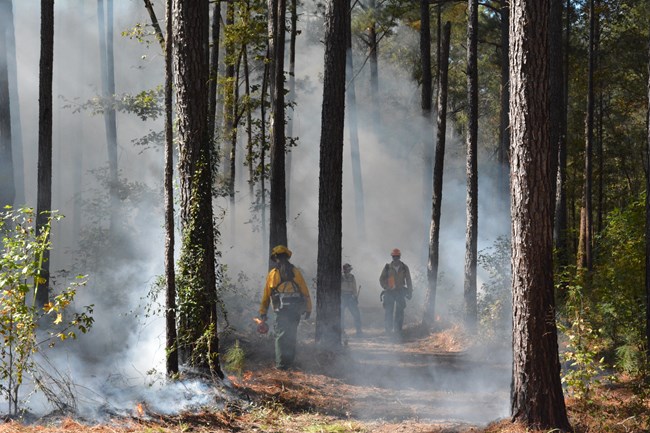
A Landscape Sustained by FireAlthough Congaree National Park is best known for its floodplain forest, a small sliver of the park is dominated by an enterirely different forest type. This area of lightly elevated land above the floodplain possesses the remnants of a vast longleaf pine forest that once stretched across the Southeast. Longleaf pine savannahs once dominated the southern landscape with an estimated 60-90 million acres. Today, longleaf pine forests are a globally threatened vegetation community, with less than 3.8 million acres remaining. This decline is due to past logging, agricultural practices, replanting with other pine species, and fire suppression. There are several rare, threatened, and endangered animal and plant species that depend on healthy longleaf pine forests to survive. Fire: An Essential ToolIt may seem strange, but one of the best tools in preventing destructive wildfires is fire itself. As leaves, branches, and trees fall to the ground, they become fuel for fires as they slowly build up. In areas where fire naturally occurs, these fuels are regularly consumed and the nutrients they contain are returned to the soil, which maintains the forest ecosystem's health. Without regularly fires these fuels build up, which can lead to catastrophic wildfires. The resulting unhealthy ecosystem can negatively impact the wildlife that calls the forest home.
Open longleaf pine forests with low shrub density and a dense herbaceous layer of grasses and forbs (flowering plants) were prevalent before logging and other agricultural practices altered the park's uplands. Red-cockaded woodpeckers, a federal endangered species, were last seen nesting in Congaree National Park in the 1990s. Widlife biologists believe there is currently not enough high-quality longleaf pinehabitat in the park to support a viable population. However, the park utilizes prescribed fires to help make the habitat more suitable in the future for red-cockaded woodpeckers. 
Adapted to FiresPrescribed fires are used to reduce forest floor leaf litter, underbrush, and small trees, restore and maintain upland forests favored by fire-adapted plants and wildlife, enhance wilderness conditions, and increase growth of native grasses and plants. 
Improving Visitor Experiences Through FireThrough prescribed fire, visitors to Congaree National Park benefit as well. A healthy upland forest improves popular recreational opportunties including birding, camping, wildlife viewing, and hiking. The park's upland forest is also the stage of Nature's more unique phenomena each year. 
Prescribed Fires for the FutureSince 1984, Congaree National Park has used prescribed fire to help in the restoration of the longleaf pine ecosystem. It is the hope that through the use of fire, the trees and the entire ecosystem will once again thrive in this landscape. The use of prescribed fire also protects the park from other threats, including reducing the risk of dangerous wildfires and reducing invasive plant species that could overwhelm native plants.Fire has been an important tool that the National Park Service has used to protect, preserve, and restore the landscape at Congaree National Park. Using prescribed fire today helps ensure that future visitors get the opportunity to experience a healthy and vibrant upland forest for generations to come. |
Last updated: May 3, 2023
